Real-Time Fire Detection Method for Electric Vehicle Charging Stations Based on Machine Vision
Abstract
:1. Introduction
- (1)
- Invoking the tenfold cross-validation algorithm and the K-means clustering algorithm in the original algorithm, which improves the generalization ability of the model and enhances not only the training speed but also the accuracy of the detection results.
- (2)
- For the problem of the low recognition rate of small-target object detection in the YOLO series algorithm, the proportion of small-size flame images in the flame dataset was increased to improve the sensitivity density of small-flame detection at the early stage of fire.
- (3)
- The on-site monitoring video of electric vehicle charging stations were used as the input video source for neural network detection, which can realize simultaneous monitoring of multiple charging stations and significantly shorten the fire emergency response time and has a good detection effect in the application of video stream-based target detection.
2. Construction of Flame Dataset
2.1. Flame Image Selection
- (1)
- A total of 1000 images of typical fires selected from the general-purpose dataset.
- (2)
- A total of 1000 images related to charging pile, electric vehicle, and charging station fires selected from existing public fire image/video databases and experimental databases of research institutions.
- (3)
- Extracting images from existing electric vehicle and charging station fire videos on the web with video clips of 1280 pixels (horizontal) × 720 pixels (vertical) and 30 frames per second (fps), and selecting a total of 1000 images.
2.2. Division of Fire Dataset
3. Design of Improved YOLOv4-Based Fire Detection Model
3.1. YOLOv4 Model-Based Detection Process Design
3.2. Improved YOLOv4 Algorithm Based on K-Means
4. Experimental Simulation Verification
4.1. Experimental Environment and Experimental Parameter Settings
4.2. Evaluation Indicators
4.3. Experimental Results
4.4. Model Comparison
- (1)
- By comparing the detection results of the three methods, it can be concluded that the YOLO series target detection algorithm achieves excellent detection results in fire detection, and the detection accuracy is above 0.95.
- (2)
- (3)
- (4)
- With introducing the K-means clustering algorithm in the original YOLOv4 network, the prediction frame size fits the flame region more closely. It achieves precise localization of the detection target while improving detection accuracy.
5. Conclusions
Author Contributions
Funding
Conflicts of Interest
References
- Qi, B.; Li, B.; Chen, L.K.; Wang, W.; Dong, L.; Jia, X.; Huang, J.; Ge, C.W.; Xue, G.M.; Wang, D. Ship Target Detection Algorithm Based on Improved Faster R-CNN. Electronics 2019, 8, 959. [Google Scholar] [CrossRef] [Green Version]
- Zhao, Y.J.; Zhang, H.B.; Zhang, X.L.; Chen, X.J. Fire smoke detection based on target-awareness and depthwise convolutions. Multimed. Tools Appl. 2021, 80, 27407–27421. [Google Scholar] [CrossRef]
- Myeongho, J.; Han-Soo, C.; Lee, J.H.; Myungjoo, K. Multi-Scale Prediction For Fire Detection Using Convolutional Neural Network. Fire Technol. 2021, 57, 2533–2551. [Google Scholar]
- Li, P.; Zhao, W.D. Image fire detection algorithms based on convolutional neural networks. Case Stud. Therm. Eng. 2020, 19, 100625. [Google Scholar] [CrossRef]
- Tanvir, A.; Ma, Y.L.; Muhammad, Y.; Belal, A.; Shah, N.; Amin, U.H.; Rahman, A. Object Detection through Modified YOLO Neural Network. Sci. Program. 2020, 2020, 8403262. [Google Scholar]
- Sang, J.; Wu, Z.; Guo, P.; Hu, H.; Xiang, H.; Zhang, Q.; Cai, B. An Improved YOLOv2 for Vehicle Detection. Sensors 2018, 18, 4272. [Google Scholar] [CrossRef] [Green Version]
- Yuki, S.; Lu, H.M.; Joo-Kooi, T.; Hyoungseop, K. Recognition of surrounding environment from electric wheelchair videos based on modified YOLOv2. Future Gener. Comput. Syst. 2019, 92, 157–161. [Google Scholar]
- Sharif, M.; Amin, J.; Siddiqa, A.; Khan, H.U.; Arshad, M.M.; Anjum, M.A.; Kadry, S. Recognition of Different Types of Leu-kocytes Using YOLOv2 and Optimized Bag-of-Features. IEEE Access 2020, 8, 167448–167459. [Google Scholar] [CrossRef]
- Wang, L.; Yang, S.; Yang, S.; Zhao, C.; Tian, G.; Gao, Y.; Chen, Y.; Lu, Y. Automatic thyroid nodule recognition and diagnosis in ultrasound imaging with the YOLOv2 neural network. World J. Surg. Oncol. 2019, 17, 12. [Google Scholar] [CrossRef] [Green Version]
- Zhang, Y.; Shen, Y.L.; Zhang, J. An improved tiny-yolov3 pedestrian detection algorithm. Optik 2019, 183, 17–23. [Google Scholar]
- Wang, K.; Liu, M. YOLOv3-MT: A YOLOv3 using multi-target tracking for vehicle visual detection. Appl. Intell. 2021, 1–22. [Google Scholar] [CrossRef]
- Fang, M.-T.; Przystupa, K.; Chen, Z.-J.; Li, T.; Majka, M.; Kochan, O. Examination of Abnormal Behavior Detection Based on Improved YOLOv3. Electronics 2021, 10, 197. [Google Scholar] [CrossRef]
- Zhang, X.; Dong, X.; Wei, Q.; Zhou, K. Real-time object detection algorithm based on improved YOLOv3. J. Electron. Imaging 2019, 28, 053022. [Google Scholar] [CrossRef]
- Abdusalomov, A.; Baratov, N.; Kutlimuratov, A.; Whangbo, T.K. An Improvement of the Fire Detection and Classification Method Using YOLOv3 for Surveillance Systems. Sensors 2021, 21, 6519. [Google Scholar] [CrossRef] [PubMed]
- Li, T.; Lv, X.Y.; Lian, X.F.; Wang, G. YOLOv4_Drone: UAV image target detection based on an improved YOLOv4 algorithm. Comput. Electr. Eng. 2021, 6, 93. [Google Scholar]
- Singha, S.; Aydin, B. Automated Drone Detection Using YOLOv4. Drones 2021, 5, 95. [Google Scholar] [CrossRef]
- Fu, H.X.; Song, G.Q.; Wang, Y.C. Improved YOLOv4 Marine Target Detection Combined with CBAM. Symmetry 2021, 13, 623. [Google Scholar] [CrossRef]
- Liu, H.; Fan, K.; Ouyang, Q.; Li, N. Real-Time Small Drones Detection Based on Pruned YOLOv4. Sensors 2021, 21, 3374. [Google Scholar] [CrossRef]
- Yu, Z.; Shen, Y.; Shen, C. A real-time detection approach for bridge cracks based on YOLOv4-FPM. Autom. Constr. 2020, 122, 103514. [Google Scholar] [CrossRef]
- Kulshreshtha, M.; Chandra, S.S.; Randhawa, P.; Tsaramirsis, G.; Khadidos, A.; Khadidos, A.O. OATCR: Outdoor Autono-mous Trash-Collecting Robot Design Using YOLOv4-Tiny. Electronics 2021, 10, 2292. [Google Scholar] [CrossRef]
- Parico, A.; Ahamed, T. Real Time Pear Fruit Detection and Counting Using YOLOv4 Models and Deep SORT. Sensors 2021, 21, 4803. [Google Scholar] [CrossRef] [PubMed]
- Kumar, S.; Gupta, H.; Yadav, D.; Ansariv, I.A.; Verm, O.P. YOLOv4 algorithm for the real-time detection of fire and personal protective equipments at construction sites. Multimed. Tools Appl. 2021, 1–21. [Google Scholar] [CrossRef]
- Schütz, A.; Schöler, V.; Krause, E.; Fischer, M.; Müller, T.; Freuling, C.; Conraths, F.; Stanke, M.; Homeier-Bachmann, T.; Lentz, H. Application of YOLOv4 for Detection and Motion Monitoring of Red Foxes. Animals 2021, 11, 1723. [Google Scholar] [CrossRef] [PubMed]
- Ng, Y.W.; Chow, W.K.; Cheng, C.H.; Chow, C.L. Scale modeling study on flame color in a ventilation-limited train car pool fire. Tunn. Undergr. Space Technol. Inc. Trenchless Technol. Res. 2019, 85, 375–391. [Google Scholar] [CrossRef]
- Chik, Z.; Aljanabi, Q.A.; Kasa, A.; Taha, M.R. Tenfold cross validation artificial neural network modeling of the settlement behavior of a stone column under a highway embankment. Arab. J. Geosci. 2014, 7, 4877–4887. [Google Scholar]
- Guo, C.; Lv, X.-L.; Zhang, Y.; Zhang, M.-L. Improved YOLOv4-tiny network for real-time electronic component detection. Sci. Rep. 2021, 11, 22744. [Google Scholar] [CrossRef]
- Jie, Y.; Leonidas, L.; Mumtaz, F.; Ali, M. Ship Detection and Tracking in Inland Waterways Using Improved YOLOv3 and Deep SORT. Symmetry 2021, 13, 308. [Google Scholar] [CrossRef]
- Yan, J.; Wang, H.; Yan, M.; Diao, W.; Sun, X.; Li, H. IoU-Adaptive Deformable R-CNN: Make Full Use of IoU for Multi-Class Object Detection in Remote Sensing Imagery. Remote Sens. 2019, 11, 286. [Google Scholar] [CrossRef] [Green Version]
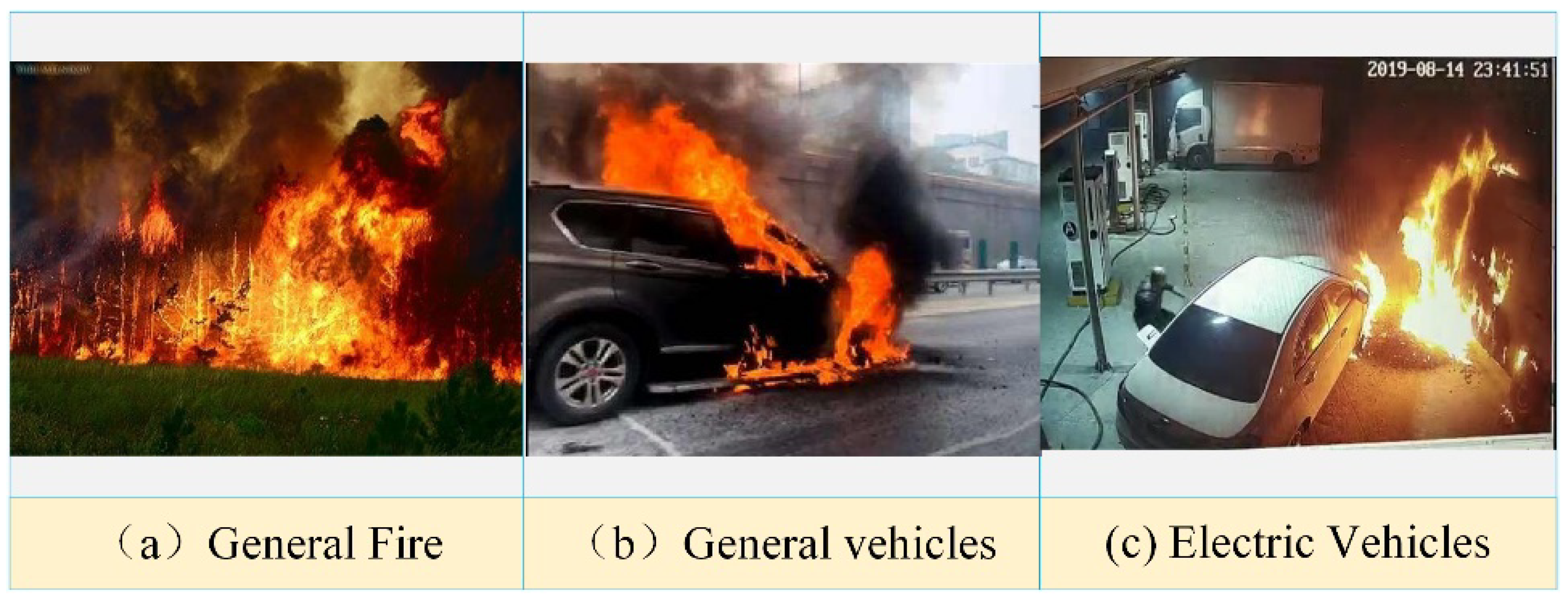
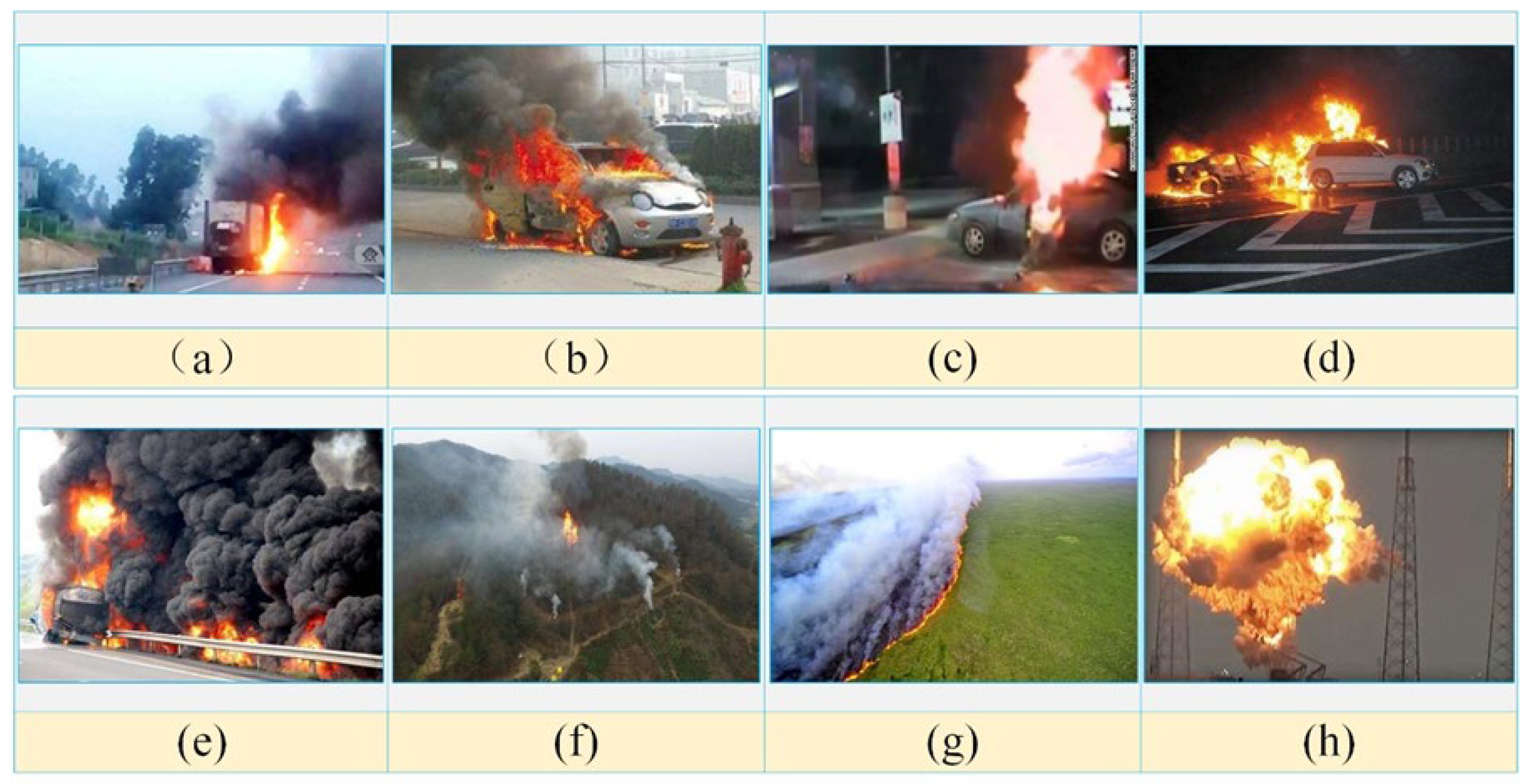
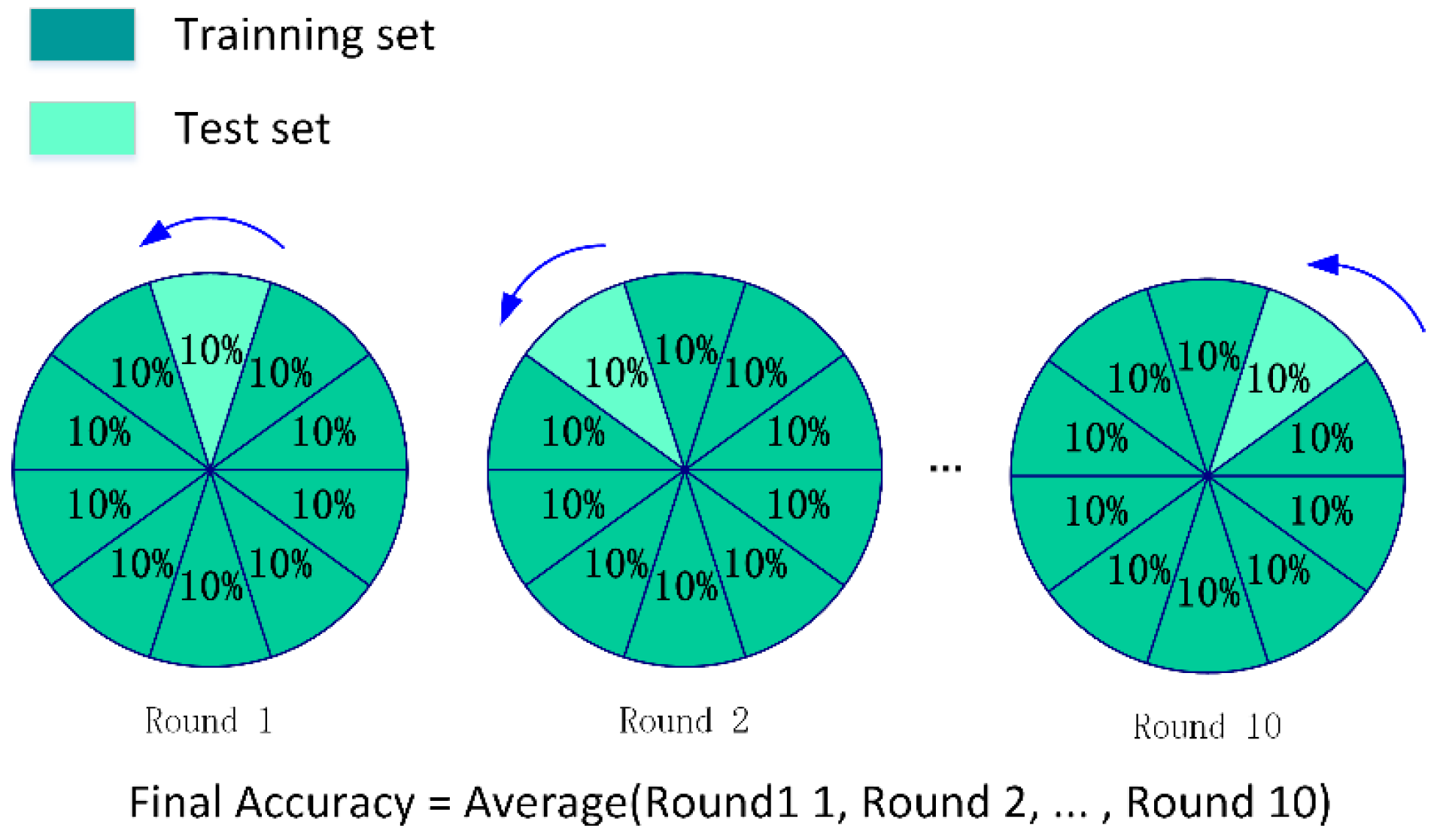

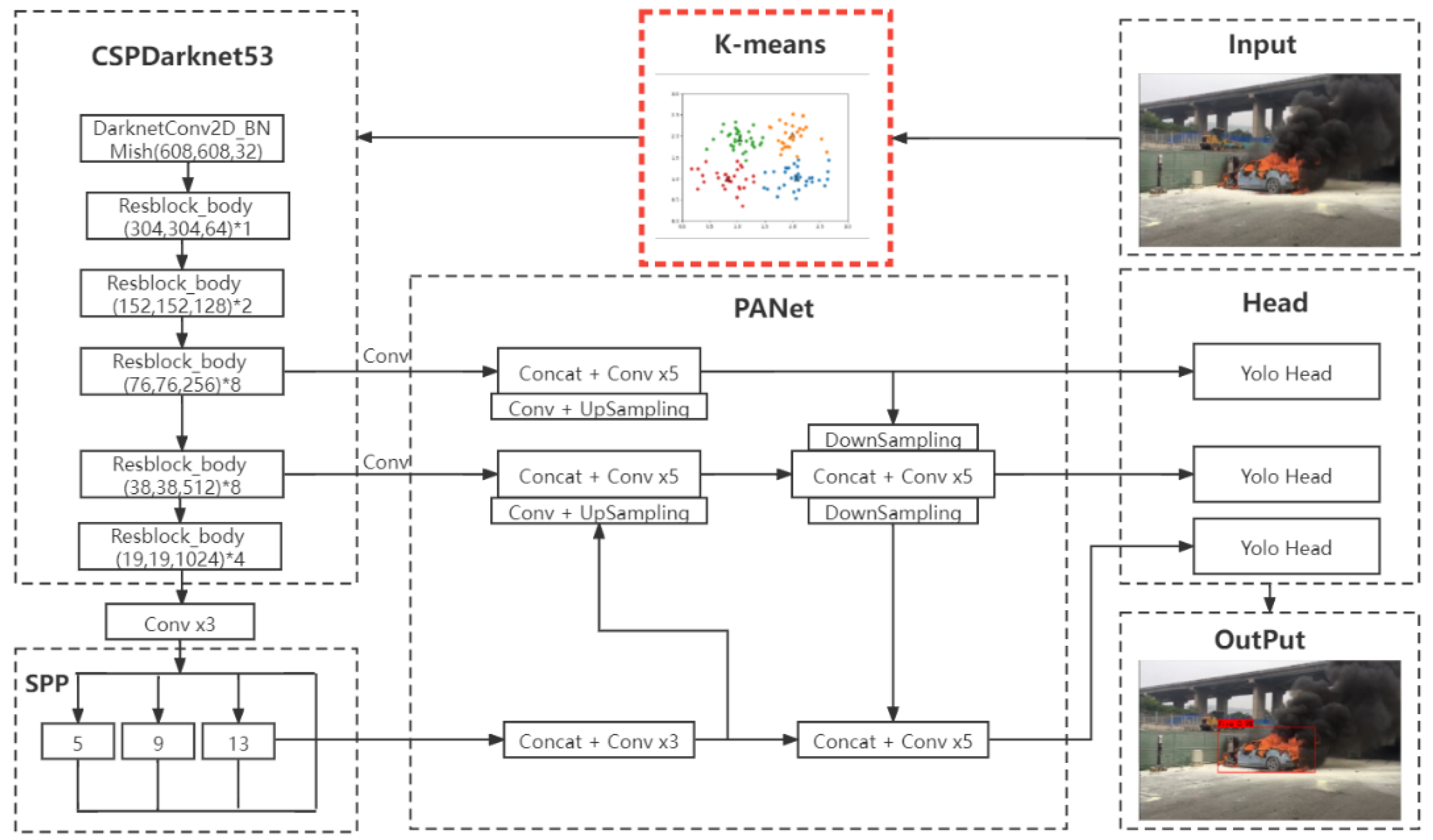
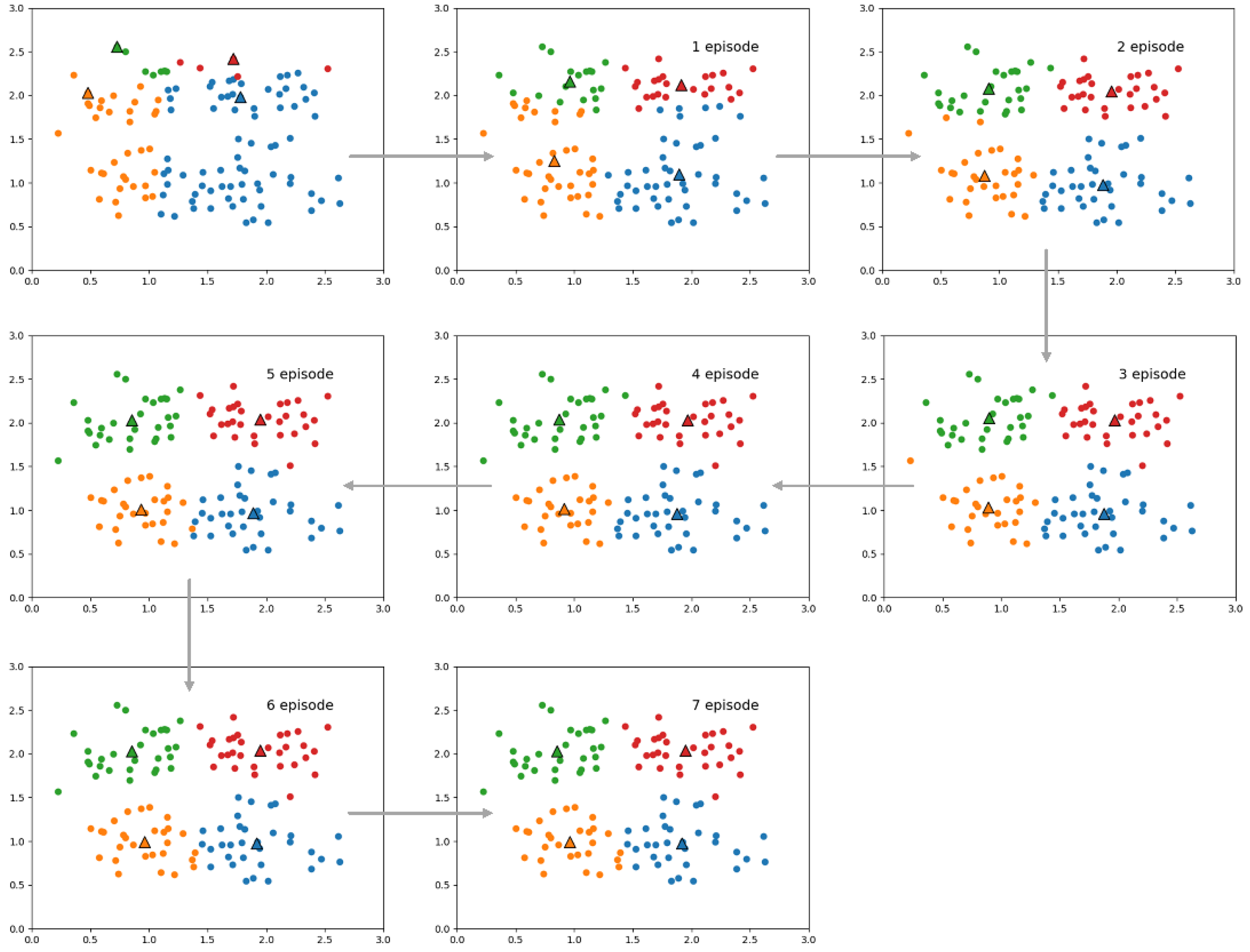
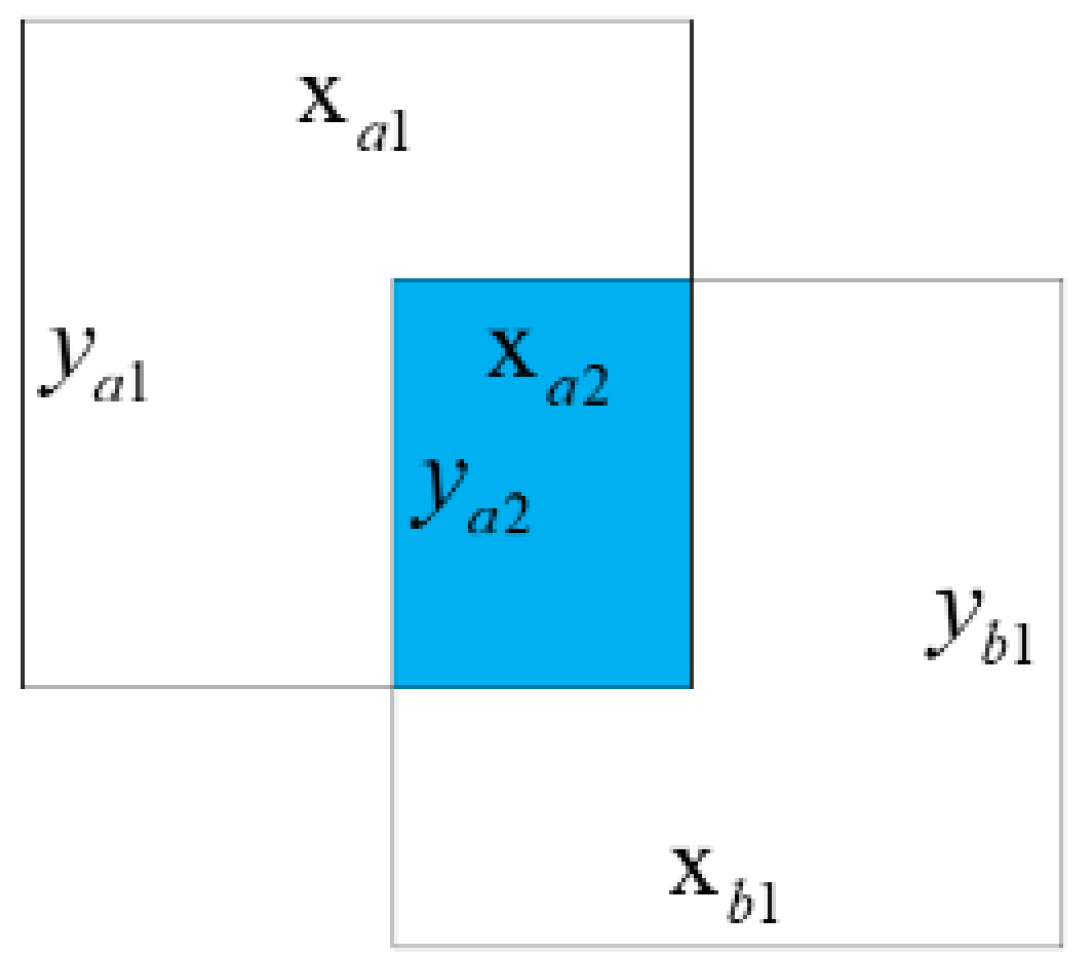

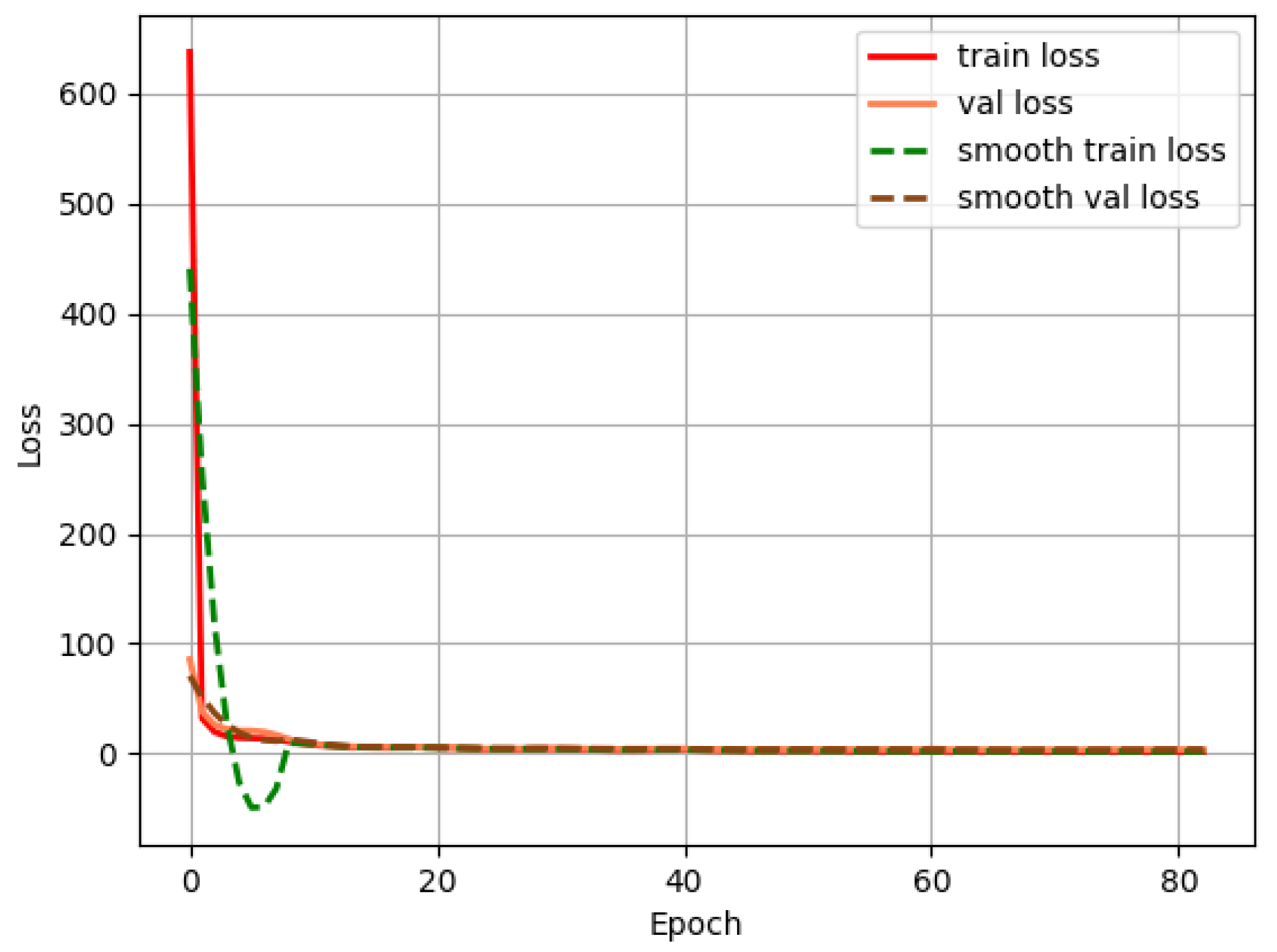
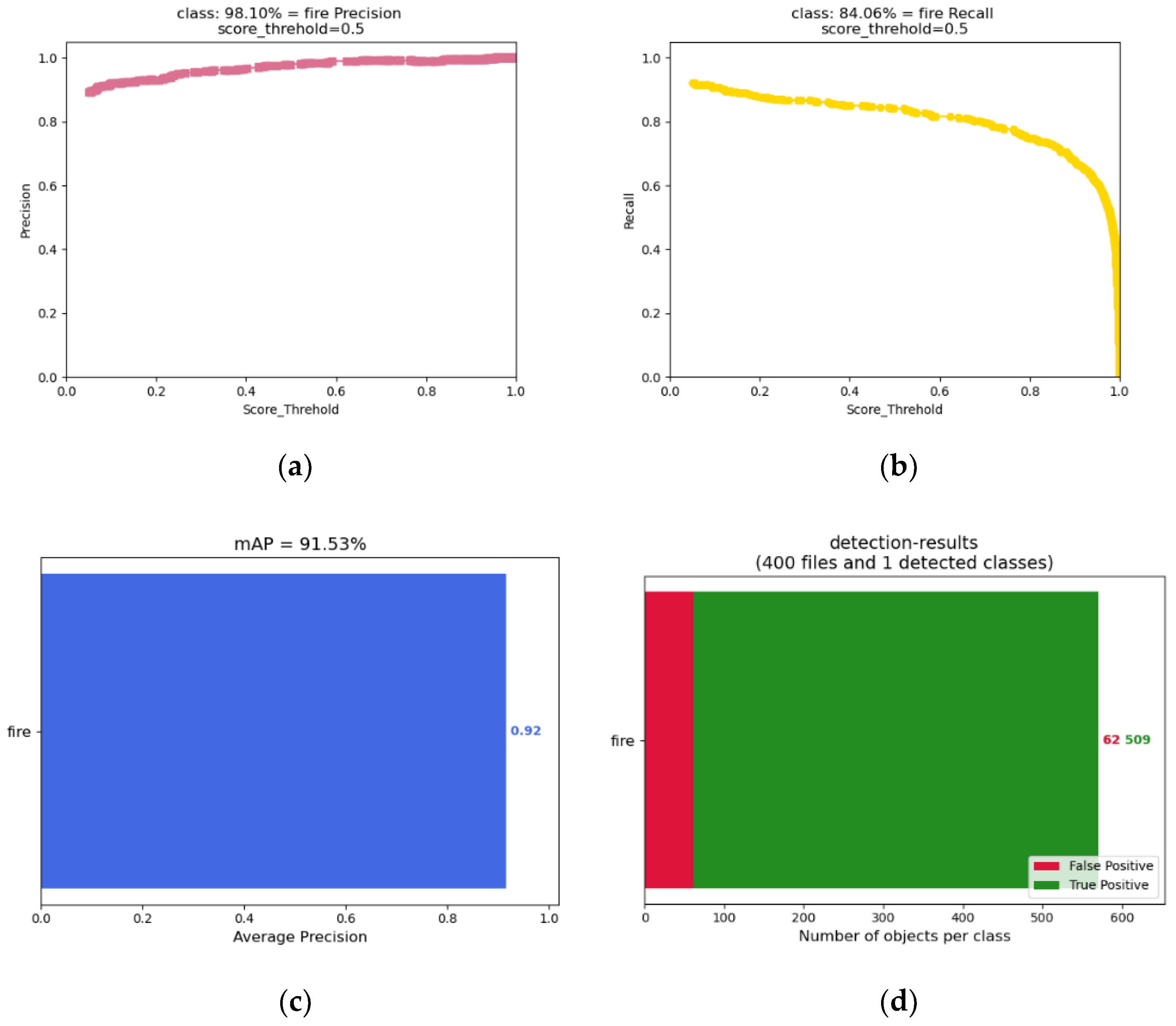
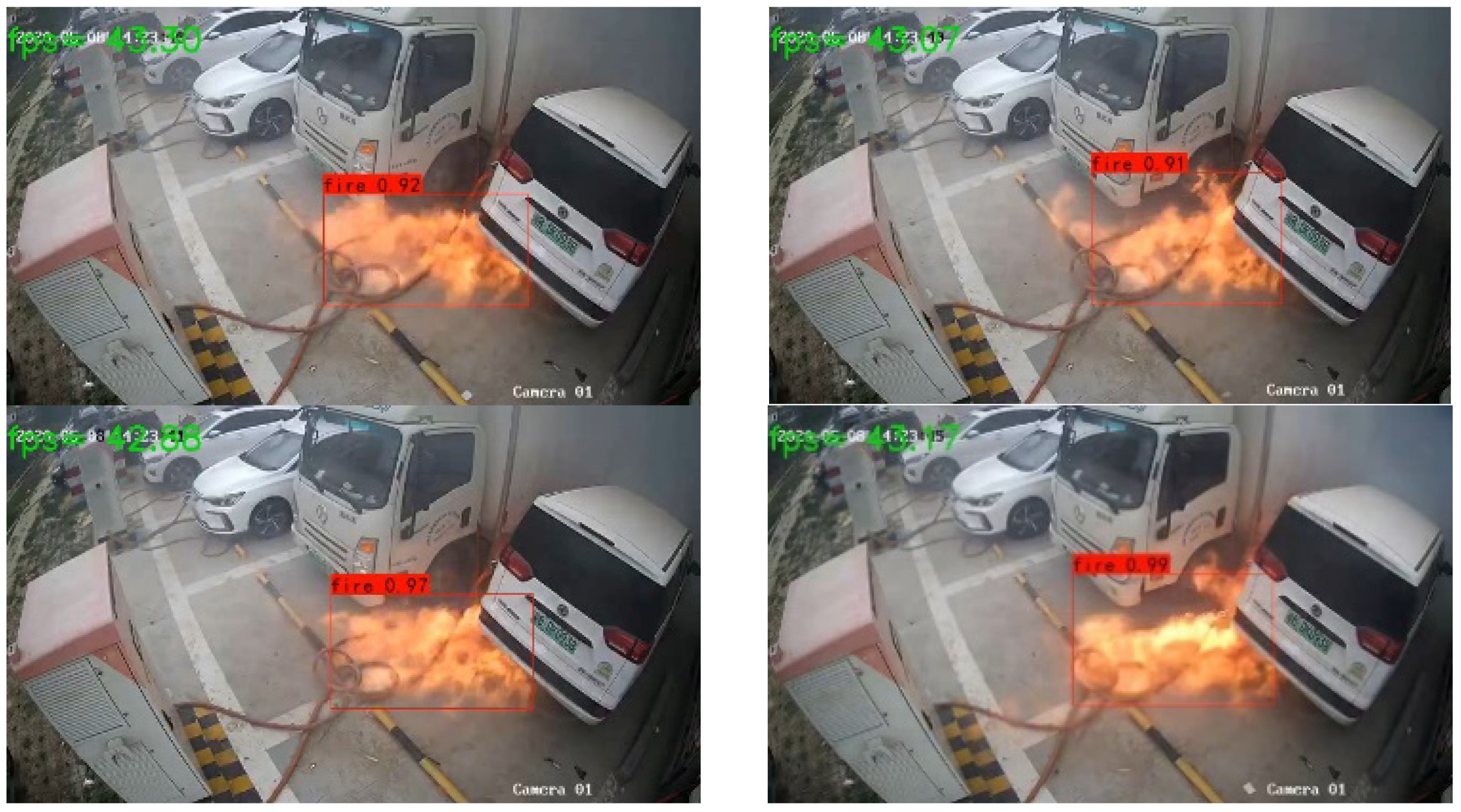
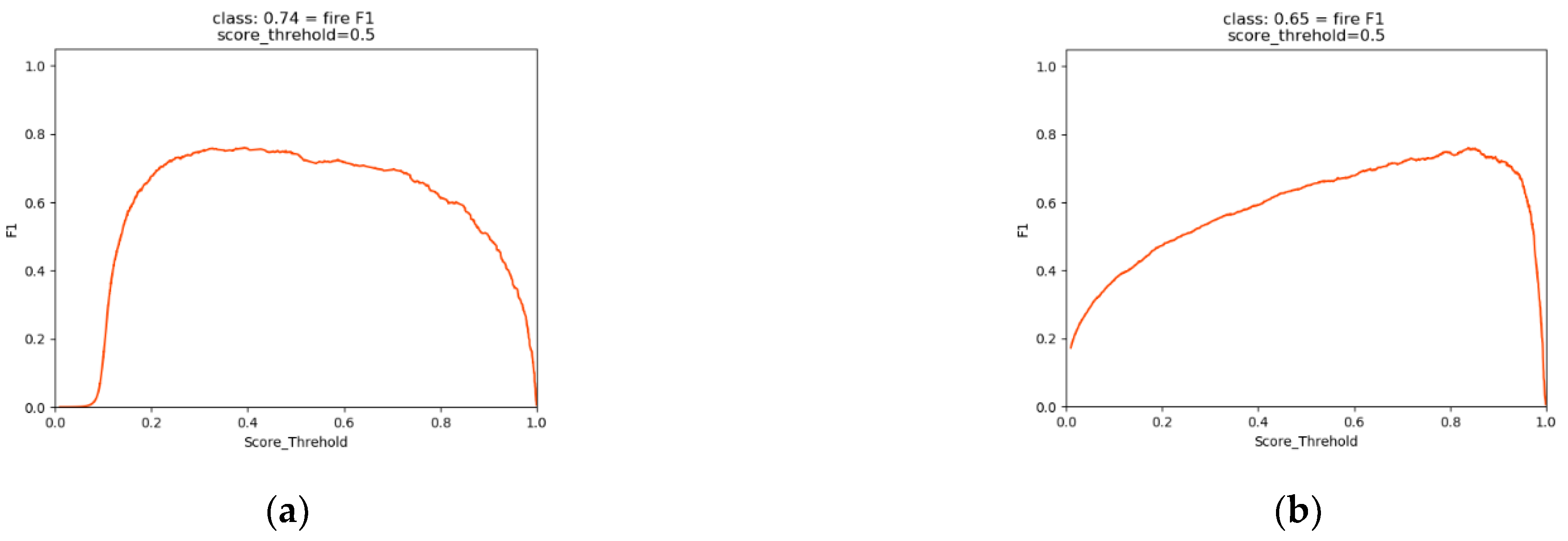




| Image Source | Type | Selection Criteria | Number (Sheets) |
|---|---|---|---|
| Web Public Datasets | Big Flame | Bright | 430 |
| Dark | 270 | ||
| Small Flame | Bright | 180 | |
| Dark | 120 | ||
| EV Charging Station | Big Flame | Bright | 1250 |
| Dark | 750 |
| Method | Backbone | Input Size | FPS | mAP(%) |
|---|---|---|---|---|
| Faster R-CNN | ResNet-101 | - | - | 59.1 |
| SSD | VGG-16 | 512*512 | 22 | 48.5 |
| YOLO | VGG-16 | 416*416 | 45.0 | - |
| YOLOv2 | Darknet19 | 416*416 | 40.0 | 21.6 |
| YOLOv3 | Darknet53 | 416*416 | 35 | 55.3 |
| YOLOv4 | CSPDarknet53 | 608*608 | 40 | 65.7 |
| Category | Parameters | |||||||
|---|---|---|---|---|---|---|---|---|
| Number of Clusters | 4 | 5 | 6 | 7 | 8 | 9 | 10 | 12 |
| Avg iou (%) | 66.97 | 70.48 | 73.89 | 75.20 | 76.41 | 78.64 | 79.01 | 79.15 |
| Dataset | Parameters | |||||||||
|---|---|---|---|---|---|---|---|---|---|---|
| VOC 2007 | Width | 12 | 19 | 40 | 36 | 76 | 72 | 142 | 192 | 459 |
| Height | 16 | 36 | 28 | 75 | 55 | 146 | 110 | 243 | 401 | |
| Flame Dataset | Width | 19 | 39 | 51 | 78 | 91 | 127 | 148 | 244 | 257 |
| Height | 29 | 48 | 87 | 146 | 66 | 217 | 105 | 180 | 312 | |
| Computer Configuration | Specific Parameters/Versions |
|---|---|
| Operating System | Windows 10 |
| CPU | Intel i7-11800HQ |
| RAM | 12 GB |
| GPU | NVIDIA RTX-3090 (24 G) |
| Python | 3.8 |
| PyTorch | 1.9.0 |
| CUDA | 11.1 |
| Types of Models | AP = mAP | Recall | Pre | F1 | Speed (Photo) | FPS (Video) |
|---|---|---|---|---|---|---|
| SSD | 76.95% | 67.26% | 82.17% | 0.74 | 0.0235 s | 28.20 |
| Faster R-CNN | 82.48% | 90.39% | 50.6.% | 0.65 | 0.0773 | 32.09 |
| YOLOv3 | 81.81% | 63.35% | 95.19% | 0.73 | 0.0332 s | 38.63 |
| YOLOv4 | 91.39% | 80.80% | 96.33% | 0.88 | 0.0306 s | 39.41 |
| YOLOv4-Kmeans | 91.53% | 84.06% | 98.10% | 0.91 | 0.0258 s | 42.57 |
Publisher’s Note: MDPI stays neutral with regard to jurisdictional claims in published maps and institutional affiliations. |
© 2022 by the authors. Licensee MDPI, Basel, Switzerland. This article is an open access article distributed under the terms and conditions of the Creative Commons Attribution (CC BY) license (https://creativecommons.org/licenses/by/4.0/).
Share and Cite
Zhang, S.; Yang, Q.; Gao, Y.; Gao, D. Real-Time Fire Detection Method for Electric Vehicle Charging Stations Based on Machine Vision. World Electr. Veh. J. 2022, 13, 23. https://doi.org/10.3390/wevj13020023
Zhang S, Yang Q, Gao Y, Gao D. Real-Time Fire Detection Method for Electric Vehicle Charging Stations Based on Machine Vision. World Electric Vehicle Journal. 2022; 13(2):23. https://doi.org/10.3390/wevj13020023
Chicago/Turabian StyleZhang, Shiyu, Qing Yang, Yuchen Gao, and Dexin Gao. 2022. "Real-Time Fire Detection Method for Electric Vehicle Charging Stations Based on Machine Vision" World Electric Vehicle Journal 13, no. 2: 23. https://doi.org/10.3390/wevj13020023
APA StyleZhang, S., Yang, Q., Gao, Y., & Gao, D. (2022). Real-Time Fire Detection Method for Electric Vehicle Charging Stations Based on Machine Vision. World Electric Vehicle Journal, 13(2), 23. https://doi.org/10.3390/wevj13020023





